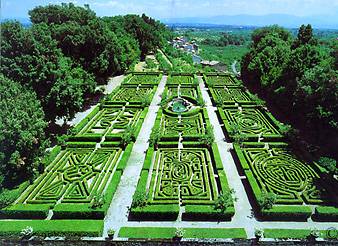
The Castle of Vignanello was built by the Benedictine monks in the ninth Century.
In 1531, following the marriage of Ortenzia Farnese with Sforza Marescotti, Paolo III Farnese commissioned the fortification of the Castle to his friend Antonio da Sangallo the Younger.
In the early 18th Century the splendid monochromatic frieze that adorn the main hall, and the vivid frescoes that embellish the ceilings of the rooms - with the pictorial cycle of the Virtues - were undertaken in honor of the visit of Pope Benedict XIII; they bear the heraldic crest of Francesco Maria Ruspoli and his wife Maria Isabella Cesi.

The garden was commissioned by Alfonso Marescotti and his wife Giulia Baglioni in the second half of the sixteenth century. The couple probably had the garden sloping down towards the valley on the south side (from a design by Vignola), and works went on during the life of Ottavia Orsini, daughter of Giulia Farnese and Vicino Orsini (who conceived the "Sacred Wood" of Bomarzo). In 1574 Ottavia married Marcantonio Marescotti, count of Vignanello.
Ottavia probably made the family residence into genuine renaissance villa through the creation of a splendid garden, forming a border between the palace and the countryside. It was build on the ridge of the promontory east of the villa, requiring the opening of a new door on the eastern side of that palace, the construction of a two-arched bridge (1611), and, above all, substantial work to level the terrain; high enclosure walls were built around the entire complex. All works would have been senseless had Ottavia not contrive to obtain, with the assistance of Cardinal Farnese, an ample supply of water from the neighboring village of Corchiano; the water was intended not only for the fish ponds and fountains, but also for the mains of the town.
In 1656 an inventory of the possessions of the estate of Vignanello described the gardens as being made up of the components that it still has today: the greenery garden, the little Secret Garden, the slightly lower down, the Barchetto, and the Barco, set on the south side of the palace, used for hunting. Northeast, beyond the garden extends the estate of The Marescotta, crossed by a broad avenue lined with boxwood hedges, and used as a wood and a fruit orchard.
the Greenery garden certainly constitutes the most interesting and best preserved part of the entire complex. It extends over a level rectangular space set along the eastern side of the palace. It is divided up into twelve compartments, whose perimeter are made up of mixed hedges of laurel, cherry-bay, laurustine, "Tarentina" myrtle, and boxwood hedges; the central compartments contain the initial of Ottavia Orsini and her sons Sforza Vicino and galeazzo.
At the corners of each compartment are the old terracotta vases holding the lemon trees.This is one of the best preserved renaissance gardens in Italy, because it still belongs to the direct descendants of Marescotti Ruspoli, who have used the same techniques of cultivation and maintenance over the generations.

